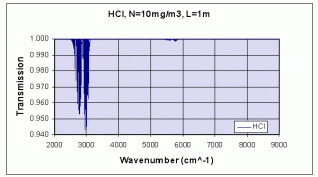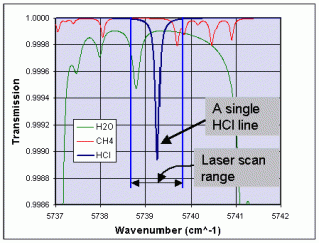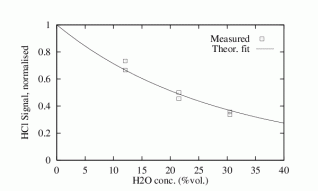Optical absorption Spectroscopy
Optical absorption spectroscopy for quantification of gas concentration has been used in industrial applications for more than 60 years. All absorption spectroscopy is based on the Beer-Lambert law, which states that transmission will decay exponentially as exp(-Sg(f)NL) where S is the absorption line strength, g(f) is the line shape function, N is the concentration of absorbing gas molecules, and L is the optical path length. For sufficiently low pressures (a few bar) many gases have distinct absorption lines. For most gases of industrial interest fundamental absorption is in the middle infra red (MIR). However, reliable diode lasers for CW room temperature operation are not yet available at wavelengths beyond 2500 nm. Therefore overtone absorption bands in the near infra red (NIR), where commercial III-V semiconductor lasers have been developed for optical communication are used in our gas measurement. This requires very high absorption sensitivity as absorption typically drops with an order of magnitude for every higher overtone.
HCl Spectrum

Fig. 1: Fundamental and overtone bands for HCl. The fundamental band is located around wavenumber 3000 while the first overtone band is located between wavenumber 5000 and 6000.
Measurement principle
Unlike conventional UV or IR spectrographic instruments, NEO Monitors' gas analysers employ the measurement principle known as 'single line spectroscopy', which eliminates cross interference from other gases. A single gas absorption line with no interference is chosen in the near IR spectral range. This absorption line is scanned with a single-mode diode laser in the following manor: a) the laser is tuned by temperature to pinpoint the centre wavelength of the absorption line and b) the laser wavelength is scanned by applying a ramp current (see Fig. 2). The simplest measurement principle is direct absorption spectroscopy, where absorption at the line centre is compared to absorption to the side of the line. However, this technique suffers from a relatively low detection sensitivity. A superior technique, which is employed by our gas analysers, is wavelength modulation spectroscopy (WMS). A high frequency modulation of the laser frequency is applied and superimposed to the current ramp. By using a lock-in amplifier, harmonic components can be selected for measurement. Our analyser detects the second harmonic signal, which is not affected by minor laser output modulations (caused by tuning the laser with current) but still strong enough for detection (amplitudes of the harmonic signals decrease for increasing harmonics). The combination of WMS and 2nd harmonic detection enable to measure relative absorption down to 10-6 and resolve gas concentrations in the low ppm and ppb range.

Fig. 2: Laser scanning of HCl absorption line in typical gas mix from waste a incinerator.
Detection limit
Detection limits for different gases depend on the specific absorption strengths and the overall detection sensitivity of the instrument. At normal transmission the detection sensitivity is limited by Etalon and laser feedback noise. Etalon noise is optical interference due to small reflections from optical surfaces. It appears as oscillations superimposed on the 2nd harmonic signal and therefore affect the measurement of the gas concentration. Etalon noise is difficult to eliminate with digital signal processing. To minimise its effects it is important to design laser-based gas monitors with a minimum of optical components between laser and detector. Our design only includes a collimating lens for the laser, a focusing lens for the detector and wedged protective windows for the transmitter and receiver units. An alternative would be to place laser and detector in a central unit and use fibre optics to the measurement point, but such a solution will make it impossible to obtain similar detection sensitivities due to the additional optical noise.
Line broadening effects
The peak amplitude of the absorption and the 2nd harmonic signal decrease with increasing line width. The amplitude of the 2nd harmonic signal is the measure for gas concentration and therefore variations in line width must be taken into account for a precise measurement.
The following phenomena will influence the line width: natural line broadening, Doppler broadening, and collision broadening. In most industrial processes collision broadening dominates. Pressure and temperature therefore strongly influence the line width. In applications where these parameters are well known such as measurements under atmospheric conditions it is easy to calibrate or correct for line broadening. However, in an industrial context there can be large variations in process conditions. Temperature and pressure are easy to measure and can be input to the instrument for continuous compensation. But collision broadening also depends on the collision cross section of the molecules. Variations in gas composition may therefore influence the line width and the 2nd harmonic signal. Gases that occur frequently in industrial processes and have a large influence on the line width are H2O, CO2, and hydrocarbons such as CH4. Figure 3 illustrates the phenomena with an example of the influence of H2O concentration on the amplitude of the 2nd harmonic signal for HCl. It is clear that such a large dependence must be compensated for.
Since the laser is scanned over the absorption line it is possible to measure the line width. The drawback of the additional line width measurement is an increase in noise in the measured gas concentration. Therefore automatic line width compensation mainly applies for applications with large variations in gas concentrations. A typical application is waste incineration. To our knowledge the gas monitors by NEO Monitors AS are the only on the market to incorporate the feature of line width compensation.
HCl vs. H20

Fig. 3: Measured second harmonic signal of an HCl line as function of H2O concentration at 270 °C (signal normalised to 1 for zero H2O concentration).